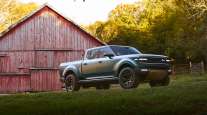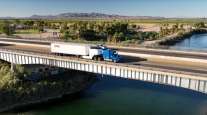E&MU: Hybrids Place Little Strain on Fleet Repair Resources
By Steve Brawner, Contributing Writer
This story appears in the May/June 2010 issue of Equipment & Maintenance Update, a supplement to the May 17 print edition of Transport Topics. Click here to subscribe today.
Hybrid engine technology is not yet ready for Class 8 over-the-road trucks, but it is making inroads in other heavy- and medium-duty applications and appears to be performing well, both on the road and in the shop.
The technology so far has added little maintenance work to technicians’ duties, officials with FedEx Corp., UPS Inc., Coca-Cola Enterprises Inc., Florida Power & Light Co. and the New York City Department of Sanitation said in separate interviews.
Routine maintenance typically involves periodically changing an air filter on the hybrid system’s air-cooled battery and checking the battery’s coolant reservoir, with intervals depending on a company’s duty cycle.
“You’re swapping out a hydraulic filter, basically, and making sure the oil stays clean,” said Spiro Kattan, supervisor of mechanics for the New York City Department of Sanitation, which is testing two hybrid hydraulic refuse trucks.
Mary Kay Runyan, director of fleet operations, North America, for Coca-Cola Enterprises, said drivers like the vehicles, and lab results have shown fuel savings in the 30% range.
As for maintenance, “I get the same feedback in the shops from our technicians and our maintenance managers,” she said. “They’re easy to maintain. . . . There are a few different preventive maintenance things that we have to do on the system, but it is a relatively simple add to the normal PM schedule that we’re already using.”
No system is perfect, of course. Sam Snyder, chief engineer of FedEx’s worldwide fleet, said software issues or unusual mechanical or electrical issues can crop up, leading to longer out-of-service times.
But problems so far are rare, especially now that the technology has moved out of the prototype phase.
Runyan said her company has yet to take any of its 336 Kenworth hybrid-electric route delivery vehicles off the road because of systemic problems. Eaton, the dominant producer of hybrid-electric engines, offers warranties of three years or 150,000 miles with optional extended warranties of two years and another 50,000 miles, if problems arise.
Hybrids typically produce energy through regenerative braking, transforming the potential energy created when the driver applies the brakes to stored kinetic energy, which is later released for acceleration.
Hybrids have proven themselves in stop-and-go applications, such as refuse service and beverage delivery. Such systems can be used not only for propulsion but also to run applications such as refrigeration in cool boxes and the buckets on utility trucks.
The two types of hybrid configuration are series and parallel.
In a series model, the wheels receive power from an electric motor driven by a battery pack or by a generator powered by the diesel engine. This type is ideal in low-speed situations, such as buses, where the vehicle is continually accelerating and decelerating and would be burning a lot of fuel shifting through gears with a diesel engine.
In a parallel configuration, two paths of energy — one diesel, one electric — propel the vehicle. This arrangement is useful at higher speeds because the efficiency of a diesel engine running through a conventional gear box is greater than the energy saved through the more numerous gear transitions made in a series hybrid.
Parallel configurations offer an advantage in that the truck can be operated solely as a diesel engine if the electrical system fails.
Hydraulic hybrids also use series and parallel setups, but the regenerative braking produces not electricity but hydraulically compressed nitrogen, which is then stored in high-pressure accumulators and released to propel the vehicle forward. Hydraulics capture a significant amount of energy very quickly but cannot store it without enormous accumulators, so they are used in large vehicles requiring many stops and starts.
Training, of course, is key for technicians, who must perform routine inspections of the low- and high-voltage cables, check for loose or damaged electrical cable connections, and check diagnostic fault codes triggered by the hybrid control system.
In most cases, end-user technicians receive a day of training from Eaton — enough time to learn routine procedures. More in-depth work is the responsibility of the dealer or the hybrid motor’s manufacturer.
That work would include changing the battery, made of cells in a “power electronics carrier,” which should last five to 10 years, said Kevin Snow, chief engineer and hybrid application development leader at Eaton Corp.
When necessary, a technician replaces the entire power electronics carrier.
None of the companies contacted has had battery failures.
“The really important thing about these batteries is they are non-serviceable,” said Darren Gosbee, Navistar’s director of hybrid and electric vehicles. “There’s no level of maintenance required. They report out when they fail, and those failures should be few and far between.”
Safety is paramount because of the hybrid system’s high voltage.
To establish standards, Eaton worked with American Trucking Associations’ Technology & Maintenance Council to produce Recommended Practice 1511. This practice describes safety procedures for servicing hybrids.
Guy Rini, an industry consultant and former director of advanced propulsion systems for Mack Trucks Inc., said it’s important that technicians learn to use the “lock-out, tag-out” method: locking out the electrical current when working on the system and tagging out the truck so that no other technician unwittingly starts the engine — which can happen with hybrids because they are silent whether or not they are running.
“It takes quite a bit of training, really, to get people comfortable with it,” Rini said. “It’s no more dangerous than a receptacle for 110 volts that you have in every room in your house, but you have to learn how to use and not use it.”
Hybrids may reduce some types of maintenance. Bill Kahn, manager of advanced concepts for Peterbilt Motors, said hybrid systems ideally would extend maintenance intervals of diesel engines because they share the load with their hybrid accessories.
Kahn said he has seen studies that show longer oil change intervals associated with hybrid systems.
Moreover, the regenerative braking process reduces stress on brake pads, extending their useful life.
Claude Masters, Florida Power & Light’s manager of vehicle acquisition and fuel, said his company hasn’t had to perform a brake job on any of its 65 bucket trucks; the first truck began service three years ago. The procedure usually is performed every two years on the rest of the fleet.
Coca Cola Enterprises’ Runyan said her company is testing to verify longer, better brake life.
FedEx’s Sam Snyder said the company has not yet conducted an in-depth study of regenerative braking, but he said conventional vehicles require two to three consecutive brake services, compared to hybrid trucks.
Because hybrids depend on regenerative braking, that’s the main reason they have not found a home among heavy-duty, Class 8 vehicles. Big trucks traveling the interstate simply don’t brake often enough to produce adequate storable energy to justify the hybrid systems’ added cost, weight and space.
Peterbilt is in the second year of a two-year field test with Wal-Mart of 10 Class 8 trucks. Engineers had hoped to validate 5% to 7% fuel savings, which would save $12,000 a year in fuel per tractor at $4 a gallon, but they have been unable to do so. The manufacturer is testing two new Class 8 systems next year. Eaton’s Snow said he expects future batteries to store more energy as new lithium-ion chemistries are developed and as battery cells change shape to pack more energy into a smaller space.
Snow also projects that Class 8 hybrid engines will become more common in two to three years, and he foresees plug-in hybrids as a viable option for heavy-duty vehicles.
Eaton is working with a government-funded program that would produce hundreds of plug-in utility trucks as well as a few shuttle vans.
Asked if hybrid engines eventually will serve in Class 8 trucks, Navistar’s Gosbee said, “Sure, for sure.”
One measure of the systems’ success is that fleets are planning to use more of them. FedEx now operates 319 hybrids and is retrofitting 92 trucks of model years 2000-2002 with Eaton hybrid-electric systems.
UPS has 50 hybrid brown trucks and has ordered 200 more.
FP&L’s Masters said the utility is saving 40% in fuel, and cost-benefit analyses have demonstrated paybacks of six years on a truck that is supposed to last 11 years.
The utility has been so pleased with the fuel savings and operational experience that it plans to buy hybrids whenever it can justify them.




